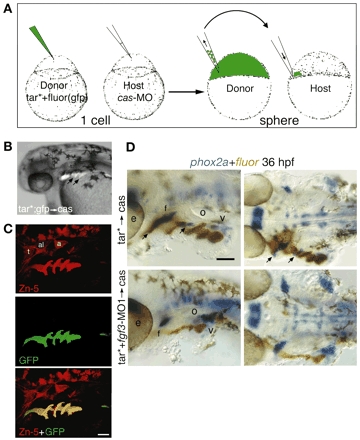Fig. 4 Pharyngeal pouch restoration is sufficient for rescuing phox2a-positive EB neurons. (A) Donor embryos were injected with a tar* mRNA and a lineage tracer (fluorescein or gfp), while host embryos were injected with cas morpholino. At sphere stage, 10-20 tar*-positive cells were transplanted to the margin of cas hosts and mosaic embryos were collected at 36 hpf. (B) Side view of the live cas-MO embryos that received tar* transplant. Arrows indicate endodermal pouches. (C) Lateral views of a cas host embryo that received tar*+gfp transplant. Zn-5 (red, top) and GFP (green, middle) were detected by immunolabeling. Note that tar*-positive cells efficiently rescue endodermal pouches (yellow overlay, bottom). (D) Side (left) and ventral (right) views of cas hosts that received tar*+fluorescein transplant with (bottom) or without (top) fgf3-MO1. Resulting embryos were processed to detect phox2a expression (blue) and fluorescein (brown) at 36 hpf. Note rescue of the glossopharyngeal and facial ganglia (arrows) in the embryos that did not receive fgf3-MO1 (top). By contrast, fgf3-MO1 tar*-transplanted cells failed to rescue EB ganglia (bottom). Scale bars: 50 µm. Abbreviations are as in Fig. 1.
Image
Figure Caption
Acknowledgments
This image is the copyrighted work of the attributed author or publisher, and
ZFIN has permission only to display this image to its users.
Additional permissions should be obtained from the applicable author or publisher of the image.
Full text @ Development

